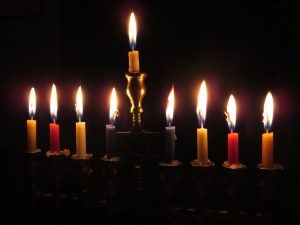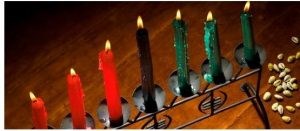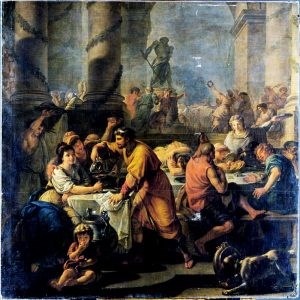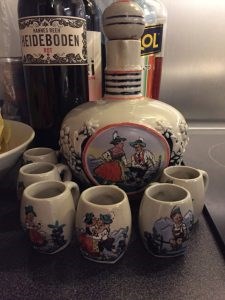This content was originally published by the Longmont Observer and is licensed under a Creative Commons license.
Roosevelt Park is festooned with lights these days, brightening the dark winter sky for scores of ice skaters revolving around the rink.
The sun set on Friday, December 21st at 4:38 pm. It is the Winter Solstice and our effort to chase away the gloom is nothing new. These are the dark days, the season with the least amount of sun. It’s no wonder that religious holidays that bring light and encourage festivities are celebrated at this time of year; it gives us all a reason to plug in the holiday lights as soon as we get home from work. We drip icicle lights from the roofline, girdle the shrubs out front with net light, or string the treetops with colored bulb, but light we must this time of year in our perennial effort to chase away the gloom of the year’s shortest day.
Alban Arthan, the winter solstice or Yule, has been celebrated since ancient times. To encourage the sun’s return, virtually every culture in the Northern hemisphere established customs that bring light to the darkness, much like our own practice of illuminating our houses.
Derived from the Nordic word “geol” (the g is pronounced with a y sound) that means both “wheel” to suggest the passage of the year and “noise and revelry”, the Norseman celebrated a Yule feast that lasted for twelve days. During this time log fires were burned to hasten the revival of the sun, shrines and homes were decorated with holly, ivy and evergreen boughs and it was an occasion for much feasting and drinking.
Viking invasions of Europe from the 9th to the 11th centuries blended Norse traditions with that of the Celts, whose pagan celebrations led by the Druids also honored the natural world. The Druids regarded the woods as places of divine presence and revered mistletoe, a parasitic plant that they considered the tears of the mighty oak. On these dark and cold December nights it is easy to understand the importance of trees and the fuel that they provided for our ancestors. The Buche de Noel, or Yule log cake, is a Christmas tradition today.

Chanukah began on December 2nd this year and the eight day festival of light brightened the darkness outside. Each night another candle was lit in the menorah, so the brightness increased through the week. Celebrating the miracle of the one day supply of olive oil that burned for eight days, foods cooked in oil are also popular during this holiday, especially latkes, or potato pancakes.

Kwanzaa celebrations link family, culture and community and commence on December 26th with the lighting of the black candle in the middle of the kinara, or candle holder, and continue until January 1. Three red and three green candles on either side are lit afterwards on the following days, representing the seven principles—unity, self-determination, collective work and responsibility, cooperative economics, purpose, creativity, and faith.

The festival of Saturnalia, December 17th, was an ancient Roman festival that honored Saturn, the youngest of the Titans, and father of the major gods of the Greeks and Romans. Introduced around 217 BC to raise the morale of the citizenry after a crushing defeat by the Carthaginians, the festival involved untying the ropes that bound the statue of Saturn during the year and a reversal of the social order so that slaves were served a banquet by their masters—though they had to prepare it beforehand.

Christmas is so widely celebrated that its origins are blurred. Yes, Christians commemorate the birth of Jesus Christ, but tales and traditions that extend from that event vary by region. There is the benevolent St. Nicholas, Sinterklkaas, Pere Noel, Kris Kringle, and Ded Moroz or Grandfather Frost. Some historians have postulated that symbolism of the flying reindeer relate to a shamanistic Lapland tradition involving the hallucinogenic mushroom Amanita muscaria, that were hung on trees to dry—much like our Christmas tree ornaments today.
So feast away this holiday season and light a candle or string some lights on a tree and celebrate like our ancestors did. It will chase away the darkness and bring new light and life to these dark days.
This year’s shortest day of the year coincides with the beginning of the full moon, what Native Americans called the Cold Moon or the Long Night Moon, marking the beginning of the coldest time of the year. The full moon will peak at 10:49 pm Mountain time on the 22nd but the close proximity of the celestial event is a rare occasion that won’t happen again until 2094.
I won’t be here to witness that, but maybe my granddaughter will. The dark sky will brighten on Friday night so look up and enjoy the light, maybe even with some shooting stars from the Ursid meteor shower thrown in. Here’s a recipe for a drink to enjoy while you see the light show.

Glühwein
Our family spent Christmas in Austria three years ago and one tradition that we brought back with us was the hot spiced wine served at the Christmas markets throughout Salzburg. It’s a great drink to warm a cold dark night.
- 1 lemon
- 1 orange
- 6 whole cloves
- 1 cinnamon stick
- ¾ cup granulated sugar
- ¾ cup water
- 1 bottle dry red wine (we like to use Beaujolais)
- ¼ cup brandy
Remove the zest from the lemon and orange with a vegetable peeler, taking care not to scrape into the bitter white pith. Place the strips of zest in a large saucepan. Juice the lemon and orange and add the juice to the pan. Add the cloves, cinnamon stick and the sugar and the water. Bring to a simmer and stir to dissolve the sugar. Simmer for 15 minutes, until the liquid is reduced by a third. Add the red wine and brandy and stir to combine. Simmer gently to blend the flavors and strain into a heated ceramic pitcher to serve or ladle into mugs from the pan.


